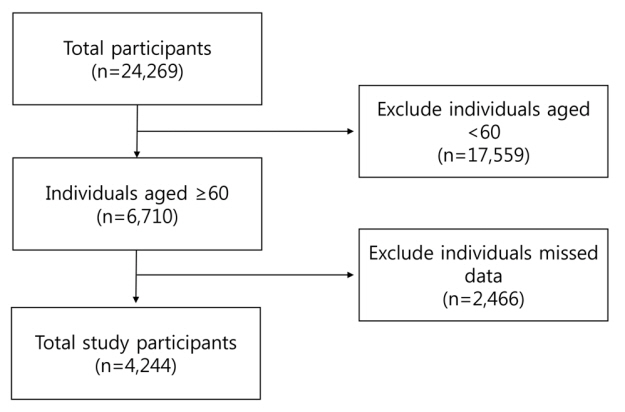1. Shin HY, Lee JY, Song J, Lee S, Lee J, Lim B, et al. Cause-of-death statistics in the Republic of Korea, 2014. J Korean Med Assoc 2016;59(3):221-32.


2. You KS, Park HS. Compison of health status between senior people living alone and those who live with their families. JKGS 2003;23(4):163-79.
3. Park YD. A study on the social welfare service of the elderly living alone in the protection of life [dissertation]. Seoul: Dongguk University; 1997;Korean.
4. Joo SS, Yoon SR. A comparative study on the general health between the couple and single aged. J Korean Gerontol Soc 1993;13:55-62.
5. Steinbach U. Social networks, institutionalization, and mortality among elderly people in the United States. J Gerontol 1992;47(4):S183-90.


7. Kim CH, Lee MR, Yoo WS. Common combinations of chronic diseases in multimorbidity and their effect on healthcare cost in Korea. KJHEP 2014;20(4):81-102.
9. Kim CH, Hwang I, Yoo WS. The common patterns of multimorbidity and its impact on healthcare cost in Korea. Health Policy and Management 2014;24(3):219-27.

10. Brody EM. Long-term care of older people: a practical guide. 1st ed. New York: Human Sciences Press; 1977. p. 103-112.
12. Choi YS. Chronic disease regular doctors pilot project model development. Wonju: National Health Insurance Service; 2009.
13. Jung YH, Ko S, Kim EJ. A study on the effective chronic disease management. Sejong: Korean Institute for Health and Social Affairs; 2013.
14. United States US Department of Health, Education, and Welfare, Public Health Service, Health Resources Administration. Hyattsville: National Center for Health Statistics; 2002.
15. van den Akker M, Buntinx F, Roos S, Knottnerus JA. Problems in determining occurrence rates of multimorbidity. J Clin Epidemiol 2001;54(7):675-9.


16. van Weel C, Schellevis FG. Comorbidity and guidelines: conflicting interests. Lancet 2006;367(9510):550-1.


18. Guthrie B, Payne K, Alderson P, McMurdo ME, Mercer SW. Adapting clinical guidelines to take account of multimorbidity. BMJ 2012;345:e6341.


20. Sok SR. A comparative study on physical health status, family support, and life satisfaction between the aged living alone and living with family. J Korean Acad Community Health Nurs 2008;19(4):564-74.
21. Kim YS. The study of the impact of the family type on the health promoting behavior and physical and mental health of elderly people. Health Soc Welf Rev 2014;34(3):400-29.

22. Kim OH. Analysis of effects which social supports and cohabiting influence on the elderly's mental health. J Scie Res 2013;22:235-56.
23. Han HK, Lee YR. A study on factors impacting on the mental health level of the elderly people living alone. J Korean Gerontol Soc 2009;29(3):805-22.
24. Choi Y. Economic and health status, social support and depression of the elderly living alone. Social Science Research Review 2008;24(4):103-23.
25. Bae SH. Study of the female elderly person who live alone in the farm and fishing village on the relationship between their exchange degree of social support and depression [dissertation]. Seosan: Hanseo University; 2007;Korean.
26. Kim SH, Kang HJ, Kim YJ. The effects of a social network for female elders living alone in rural and fishing villages on their quality of life. Korean J Fam Welf 2008;13(3):51-71.
27. Kim TH, Jun GY. A study on the conjugal support, the share of household activities and marital adjustment in old age. JKGS 1997;17:167-82.
28. Kim TH, Kim SJ. A study on the solidarity between the elderly and their three generations, and depression of the elderly. J Korean Gerontol Soc 1996;16(1):110-29.






 PDF Links
PDF Links PubReader
PubReader ePub Link
ePub Link Full text via DOI
Full text via DOI Download Citation
Download Citation Print
Print


